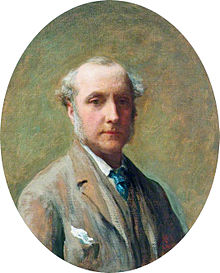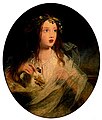art.wikisort.org - Artist
James Sant CVO RA (1820–1916) was a British painter specialising in portraits and known particularly for images of women and children[1] and artistic exploration of the symbolism of childhood.[2] He was a member of the Royal Academy.[3] George Sant and Sarah Sant were also artists and are believed to have been his brother and sister.[4]
This article has multiple issues. Please help improve it or discuss these issues on the talk page. (Learn how and when to remove these template messages)
|

Biography
Sant was born in Croydon, Surrey, England, on 23 April 1820. He was taught first by the watercolourist John Varley, then by Augustus Wall Callcott,[5] then from the age of twenty was taught by the Royal Academy Schools.
He lived to the age of 96 and exhibited at the Grosvenor Gallery as well as producing nearly three hundred canvases for exhibition at the Academy. The first of these, a portrait of his father William Sant,[6] was exhibited in 1840;[7] the last was exhibited in 1915. In 1851 he married Elizabeth (Eliza) Thomson, daughter of Dr R.M.M. Thomson, a surgeon and member of the Agri Horticultural Society of India.[8] His 1853 picture of the infant Samuel was his first popular success, and engravings of this and of Little Red Riding Hood and The Soul's Awakening sold in great numbers.
In 1861, his portraits of friends and relatives of Frances, Lady Waldegrave were exhibited by Ernest Gambart at his Gallery in Pall Mall. This enhanced his reputation and he was elected ARA, and later RA; in 1871 he was appointed Principal Painter in Ordinary (official portraitist) to Queen Victoria, having become known for his portraits of the royal children and in particular his 1870 portrait of Prince Leopold and Princess Beatrice.[9] He was the last artist to hold the title.
Sant is best known for his portraits, particularly of women and of children; he was "the emperor of children," in the words of the Athenaeum. Nevertheless, many of his pictures were landscapes and particularly gardens; he also painted seascapes, landscapes with animals, and other subjects including the Wish Tower,[10] a Martello Tower at Eastbourne. His later pictures are freer in style; some have been favourably compared with the work of the French Impressionists[11] and some have a visionary or mannerist quality; his landscapes could include figures with blank or distorted features or simple silhouettes such as the nun in Convent Walls (1910).[12] He continued painting into old age; All My Fancy! (1910), an Italian landscape with villa and hills, he painted in bed from memory.[13]
He became a Commander of the Royal Victorian Order (CVO) in 1914 and resigned from the RA in the same year to "make room for younger men." He died in Lancaster Gate, London, on 12 July 1916. His work can be found at the Tate Gallery and at the National Portrait Gallery.
His sister Sarah Sherwood Clarke was also an accomplished artist: but all that is presently known of her work is a collection of 48 different views of Scotland from 1854;[14] these were exhibited for the first time at the "Watercolours & Works on Paper Fair" in London in February 2010.[15] She married Frederick Clarke, Superintendent and later Secretary of the London and South Western Railway.
His brother George Sant RBA (Royal Society of British Artists)(1821–1877) was a landscape painter and the two brothers occasionally collaborated on paintings. Both James and George Sant were among the notable artist acquaintances of Charles Dodgson (Lewis Carroll); James Sant, his daughter Sarah Fanny[16] and son Jemmy were the subjects of photographic studies by Dodgson.[17]
At auction, Sant's work can achieve hundreds of pounds sterling or hundreds of thousands of pounds depending on size, quality and subject matter.[18] Allegorical subjects remain popular; Courage, Anxiety and Despair: Watching the Battle (circa 1850) achieved £61,250 in 2012[19] and Astronomy almost twice this in 2008.[20] His The Schoolmaster's Daughter (1871) and Miss Martineau's Garden (1873) are illustrated in Victorian Painters by Jeremy Maas;[21] The Seventh Earl of Cardigan Relating the Story of the Cavalry Charge of Balaclava...(1854) is illustrated in the same volume and in Victorian Painters by Christopher Wood.[22] Sant's work can be seen at Southside House, Wimbledon, and at the National Portrait Gallery.[23] Many of his works were reproduced as prints during his lifetime; his Courage has since been reproduced as a greetings-card and his Hilda Pennington-Mellor, aged three (1880) as a post-card.[24]
Gallery
- Self Portrait, 1844
- Portrait of his wife Elizabeth and daughter, 1852
- A Thorn Amidst the Roses, 1887
- The Novice, 1856
- Ophelia
- Russell Sisters, 1858
- The Duet
- The Fairy Tale, 1845
- Courage, Anxiety and Despair: Watching the Battle
- Prince Leopold
- Princess Louise of Wales
- Princess Helena and Princess Louise
- Prince Ernest of Hesse
- Henri, duc d'Aumale
Legacy and offices
Sources
- Biography with photo
- Obituary
- Acquaintance with Lewis Carroll
- James Sant's son photographed by Lewis Carroll
References
- Jeremy Maas (1988). Victorian Painters. Barrie & Jenkins. p. 215. ISBN 0-7126-2051-6.
- "James Sant, C.V.O., R.A. (1820–1916)". Retrieved 22 April 2017.
- "James Sant (1820–1916), Painter". Retrieved 22 April 2017.
- "James Sant". Retrieved 22 December 2015.
- "The Library of Nineteenth Century Photography". Retrieved 24 September 2015.
- "Sant, James (1820–1916), portrait and genre painter". Retrieved 22 December 2015.
- "Classical Portrait of a Man". Retrieved 22 December 2015.
- "James Sant; Eliza Sant (née Thomson)". Retrieved 22 April 2017.
- Gere, C. (2010). Artistic Circles: Design & Decoration in the Aesthetic Movement. Harry N. Abrams. p. 42. ISBN 978-1-85177-602-3. Retrieved 1 May 2019.
James Sant, who in 1871 succeeded Sir George Hayter as Queen Victoria's Principal Painter-in-Ordinary, had a successful career as a portrait painter.
- "Martello towers". Retrieved 22 April 2017.[permanent dead link]
- Sir Charles Holmes. The National Gallery: France and England. G Bell & Sons Ltd. p. 240.
- "Convent Walls". Retrieved 12 May 2017.
- "All My Fancy". Retrieved 22 April 2017.
- "Sarah Sherwood Clarke nee Sant". Retrieved 22 April 2017.
- "Watercolours + Works on Paper". Retrieved 24 September 2015.
- "James Sant (1820–1916), Painter". Retrieved 22 April 2017.
- "Lewis Carroll". Retrieved 24 September 2015.
- "Art auction result for James Sant". Retrieved 22 January 2018.
- "Courage, Anxiety and Despair: Watching the Battle". Retrieved 22 January 2018.
- "Art auction result for James Sant". Retrieved 22 January 2018.
- Jeremy Maas (1988). Victorian Painters. Barrie & Jenkins. ISBN 0-7126-2051-6.
- Christopher Wood (1999). Victorian Painters. Antiques Collectors' Club. ISBN 1-85149-172-4.
- "James Sant (1820–1916), Painter". Retrieved 22 January 2018.
- "Other postcards". Retrieved 22 January 2018.
External links
![]() Media related to James Sant at Wikimedia Commons
Media related to James Sant at Wikimedia Commons
- Works by or about James Sant at Internet Archive
- 67 artworks by or after James Sant at the Art UK site
На других языках
[de] James Sant
James Sant (* 23. April 1820 in Croydon; † 12. Juli 1916 in London) war ein britischer Maler.- [en] James Sant
[fr] James Sant
James Sant (né à Croydon, Surrey, Angleterre, le 23 avril 1820 et mort en 1916) est un peintre britannique spécialisé dans les portraits, en particulier de femmes et d'enfants[1].[it] James Sant
James Sant (Londra, 23 aprile 1820 – Londra, 12 luglio 1916) è stato un pittore inglese.[ru] Сент, Джеймс
Джеймс Сент (англ. James Sant; 23 апреля 1820, Кройдон — 2 июля 1916, Лондон) — английский художник.Другой контент может иметь иную лицензию. Перед использованием материалов сайта WikiSort.org внимательно изучите правила лицензирования конкретных элементов наполнения сайта.
WikiSort.org - проект по пересортировке и дополнению контента Википедии













